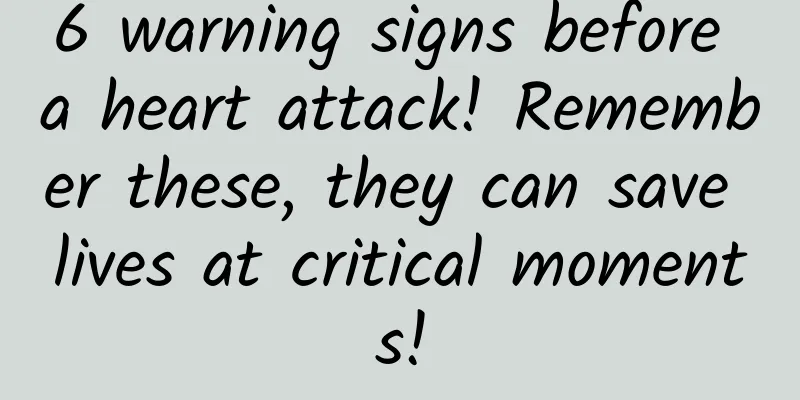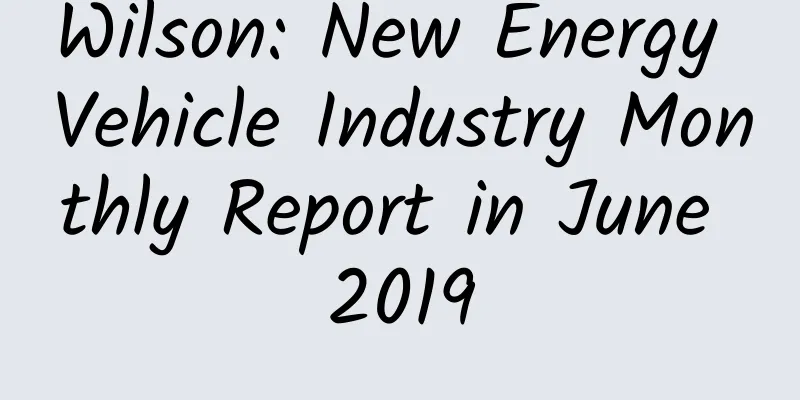6 warning signs before a heart attack! Remember these, they can save lives at critical moments!

|
November 20th is "China's Myocardial Infarction Treatment Day". I believe everyone is familiar with myocardial infarction. Myocardial infarction (MI) is a life-threatening emergency that mainly affects the elderly. As China's aging population becomes more serious, the mortality rate of acute myocardial infarction (AMI) has also shown an overall upward trend from 2002 to 2020, and has continued to be higher in rural areas than in cities in recent years. So, who are the high-risk groups for MI? What symptoms may indicate MI? References [1]: Trends in mortality from acute myocardial infarction in urban and rural areas of China from 2002 to 2020 Why does myocardial infarction occur? Simply put, myocardial infarction is a sudden blockage of the coronary arteries of the heart, leading to myocardial ischemia and hypoxia, and eventually myocardial cells die due to lack of sufficient oxygen . Why does it get clogged? This is related to many factors in our daily life. As we age or because of an unhealthy lifestyle , the coronary arteries may gradually form atherosclerotic plaques due to the deposition and accumulation of lipids. Atherosclerosis is a chronic process that causes the blood vessel walls to become thick and hard. The most dangerous moment often occurs after these plaques rupture: platelets quickly gather at the rupture site to form a thrombus, instantly blocking the coronary artery and interrupting the blood supply to the myocardium. Imagine that blood vessels are like a transportation channel. When this channel is blocked, the myocardium will be damaged or even necrotic due to lack of oxygen. In addition to the age development mentioned above, long-term exposure to chronic diseases such as high blood pressure, high cholesterol, and diabetes is also a risk factor for myocardial infarction . In addition, bad lifestyle habits such as smoking, obesity, and lack of exercise can greatly increase the risk of myocardial infarction. In addition, acute stressful events , such as sudden intense emotions, excessive physical activity, or even acute illnesses such as severe infections, may become the "last straw" and trigger a heart attack. Copyright images in the gallery. Reprinting and using them may lead to copyright disputes. The risk factors for different populations may vary. For example, women usually benefit from the protective effect of estrogen before menopause, and their incidence of myocardial infarction is lower than that of men, but this protective effect disappears after menopause, and the risk increases significantly. In addition, diabetic patients need to be especially vigilant, as their symptoms of myocardial infarction may be atypical, and they may not even have obvious chest pain during a myocardial infarction. Instead, they may have symptoms such as fatigue, nausea, or shortness of breath, which can be easily overlooked. So, how do we identify myocardial infarction? Premonition symptoms before a heart attack A heart attack usually does not come without warning. In fact, many people experience a series of premonitory symptoms in the days or even weeks before a heart attack. If these signs can be recognized early and medical attention is sought promptly, fatal consequences may be avoided. 1 Chest discomfort First of all, chest discomfort is one of the most common precursors. Many patients with myocardial infarction will feel chest oppression, stuffiness or dull pain before the attack, and this discomfort may last for several minutes or recur. Unlike severe pain, these discomforts are sometimes ignored, especially if the patient finds them tolerable or attributes them to another health problem. Such symptoms are often related to myocardial ischemia, reflecting restricted coronary blood flow, and may worsen with activity or improve with rest. Copyright images in the gallery. Reprinting and using them may lead to copyright disputes. 2 Pain or discomfort in the upper body Secondly, pain or discomfort in the upper body also needs attention. The pain of myocardial infarction is not always limited to the chest, and sometimes radiates to the shoulders, arms, back, neck or jaw, especially on the left side. Unlike acute and severe pain, this diffuse pain may appear as dull pain or soreness, and patients can easily mistake it for muscle strain or indigestion. 3 Shortness of breath Shortness of breath is another important symptom. Before a heart attack, some people may feel shortness of breath without significant activity, or even need to breathe hard. This symptom is usually accompanied by chest discomfort and may worsen when resting, especially when lying flat on your back. 4 Digestive discomfort In addition, digestive tract discomfort is also one of the potential signals, especially more common in female patients. It manifests as upper abdominal pain, nausea, heartburn or vomiting, which is easily confused with gastrointestinal diseases, leading to delayed medical treatment. These symptoms are usually related to insufficient cardiac perfusion, especially when microcirculation disorders are caused by coronary artery lesions. 5 Sudden onset of extreme fatigue or weakness Sudden onset of extreme fatigue or weakness is also a cause for concern. Many patients experience unexplained general fatigue before a heart attack, feeling exhausted even after completing light activities, and this fatigue may last for several days. Women in particular are more likely to experience this unusual fatigue in the weeks before a heart attack, studies have shown. 6 Cold sweat, dizziness and palpitations Finally, autonomic symptoms such as cold sweats, dizziness, and palpitations are also commonly reported, especially when a heart attack is about to occur. This cold sweat often occurs at the same time as emotional distress or a "near-death feeling", and the patient may feel extremely uncomfortable or even panic. In general, the precursor symptoms of myocardial infarction vary from person to person, especially women and the elderly may have atypical manifestations. Therefore, do not ignore these signals from the body, especially in the case of previous risk factors for heart disease, it is particularly important to seek medical attention in time. What should I do if I have a heart attack? Once a heart attack occurs, it is crucial to respond correctly and quickly, as this may directly affect life or death. First, stop all activities immediately . No matter what you are doing, stop immediately, sit down or lie down, and try to stay quiet. This can reduce the burden on the heart and avoid aggravating the condition. At the same time, do not force yourself to move, such as trying to drive to the hospital by yourself, which is extremely dangerous. Next, call 120 immediately for emergency help . This is the key to time. Describe your symptoms clearly, such as the location and nature of your chest pain, and whether you have shortness of breath or cold sweats. This can help emergency personnel make accurate judgments more quickly. While waiting for help, don't panic and stay calm. If you have family or friends around you, you can also ask them to help calm you down. If you have emergency medications on hand, such as nitroglycerin or aspirin, and you are sure you are not allergic to these drugs, you can take them before the ambulance arrives. Nitroglycerin can help dilate blood vessels and relieve chest pain; while aspirin can inhibit platelet aggregation and reduce the risk of thrombosis. But be careful when taking nitroglycerin to prevent fainting caused by a sudden drop in blood pressure. If the patient loses consciousness and stops breathing, people around should immediately perform cardiopulmonary resuscitation (CPR). The golden time for CPR is very limited, and taking measures in the first place may save lives. When compressing, you need to maintain the rhythm and depth of chest compressions until emergency personnel arrive. If you are not sure how to perform CPR, the operator of the emergency call can also give you instructions. Finally, when you arrive at the hospital, the doctor will take a series of emergency treatment measures according to the condition, such as thrombolytic therapy or coronary artery stent surgery , to restore blood flow and reduce myocardial damage. Remember, the treatment effect of myocardial infarction is closely related to the time of medical treatment. The earlier you receive treatment, the less myocardial damage you will suffer and the higher your survival rate will be. Therefore, when facing a myocardial infarction, you must not be lucky and must seek professional help as soon as possible. Myocardial infarctions do not choose time or place. Knowing the symptoms and coping methods of myocardial infarction can save lives at critical moments. For the sake of your heart health, you should have regular physical examinations, maintain good living habits, and stay away from the risk of cardiovascular disease. It is best for high-risk groups to establish a one-click emergency contact to avoid being unable to call the emergency number. References [1]Hu SS; Writing Committee of the Report on Cardiovascular Health and Diseases in China. Epidemiology and current management of cardiovascular disease in China. J Geriatr Cardiol. 2024;21(4):387-406. [2]Wereski R, Kimenai DM, Bularga A, et al. Risk factors for type 1 and type 2 myocardial infarction. Eur Heart J. 2022;43(2):127-135. [3]Anand SS, Islam S, Rosengren A, et al. Risk factors for myocardial infarction in women and men: insights from the INTERHEART study. Eur Heart J. 2008;29(7):932-40. [4]Bahr RD. Acute prevention of a heart attack: Early identification of prodromal symptoms as the Rosetta Stone in decoding the heart attack problem. Herz. 2024;49(3):167-174. [5]Schulte KJ, Mayrovitz HN. Myocardial Infarction Signs and Symptoms: Females vs. Males. Cureus. 2023;15(4):e37522. Planning and production Author: Jiang Yongyuan, Master of Internal Medicine, Third Military Medical University Reviewer: Wang Qian, Chief Physician of the Emergency Department, the Third Medical Center, PLA General Hospital Planning丨Wang Mengru Editor: Wang Mengru Proofread by Xu Lailinlin Note: The cover image is a copyrighted image. Reprinting it may cause copyright disputes. |
<<: In order to restore the ecology, they decided to play "music" outdoors
>>: Why did sugarcane "conquer" the world?
Recommend
The conversion rate of information flow is only 10%, so where does the remaining 90% of traffic go?
The most painful thing in marketing promotion is:...
Is there really no solution to getting pregnant with trisomy twice in a row?
I saw a netizen saying that she and her husband h...
Why would a spider magnified 100 times be crushed by itself?
Today we are going to talk about a topic that is ...
How to promote men’s skin care products? What are the promotion methods?
Many brands of men's skin care products are n...
Is it difficult to convert users into promotion? Catering to the fun point is the key
With the development of information flow advertis...
Google recruitment information leaked: Android Studio can be used to develop Android systems
Google recently released a new job posting on its...
Content payment: Your thirst for knowledge makes Luo Zhenyu and others earn tens of millions a year
Paying for content has its origins. The concept h...
Honor XSport headphones: shark fin design, strong waterproof and long battery life to fuel sports
Music has become an indispensable part of people&...
Is the amount of study you insist on every day 365 times or 365 times?
I believe everyone remembers that when we were in...
JD.com is making profits across the board, so why did Liu Qiangdong, the top philanthropist, cut the salaries of his “brothers”?
On the morning of November 22, Liu Qiangdong issu...
What time should I check the examination venue for the college entrance examination? What should I pay attention to when checking the examination venue for the college entrance examination? 2020 Shandong College Entrance Examination Examination Time
Tomorrow morning, the 2020 college entrance exami...
A collection of 40 films by Eric Tsang, all of Eric Tsang's films can be downloaded from Baidu Cloud
A collection of 40 films by Eric Tsang, all of Er...
Netflix aims to disrupt the entire TV industry
In recent months, the media has been heavily invo...
Station B Operation: UP Master Creation Manual!
B Station Operation : General Contents of B Stati...
Analysis of Pinduoduo’s marketing activities!
I think everyone is familiar with the product Pin...









